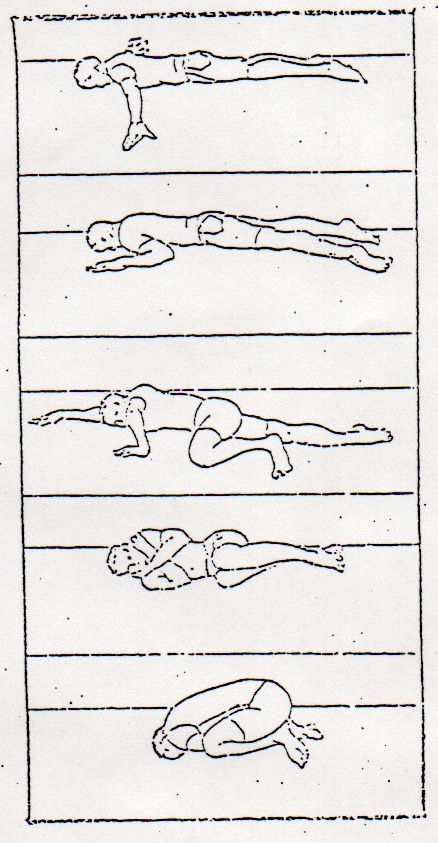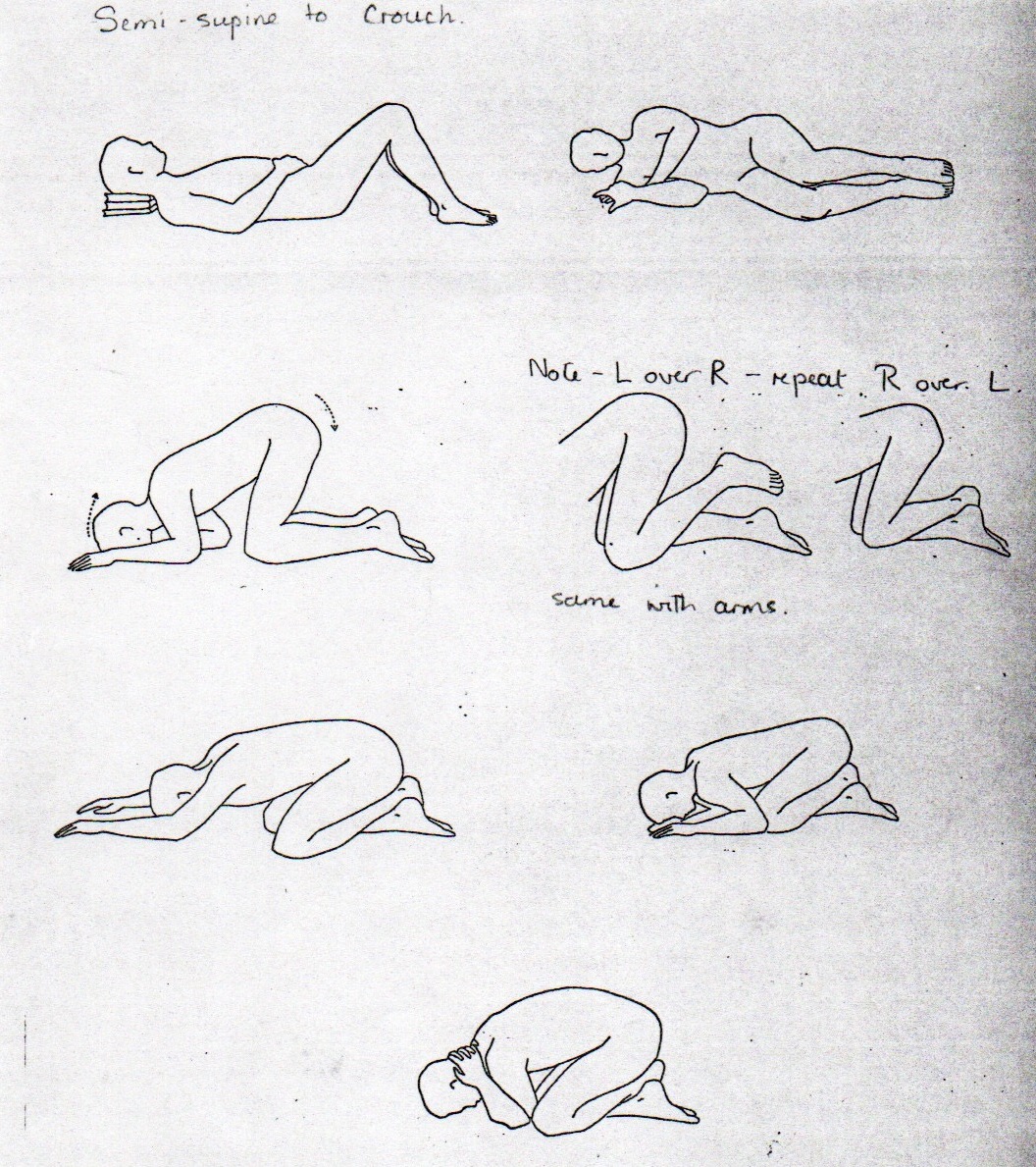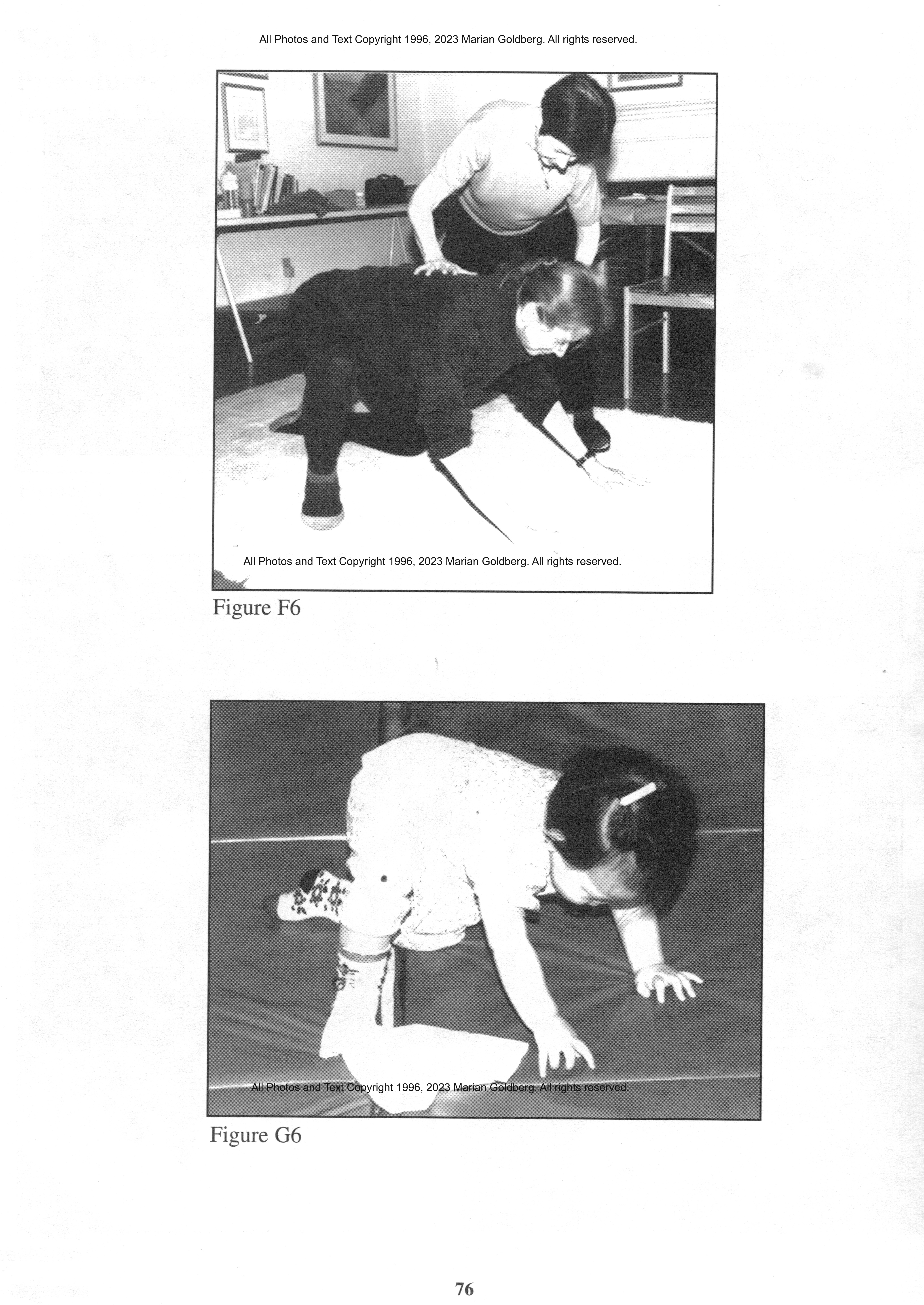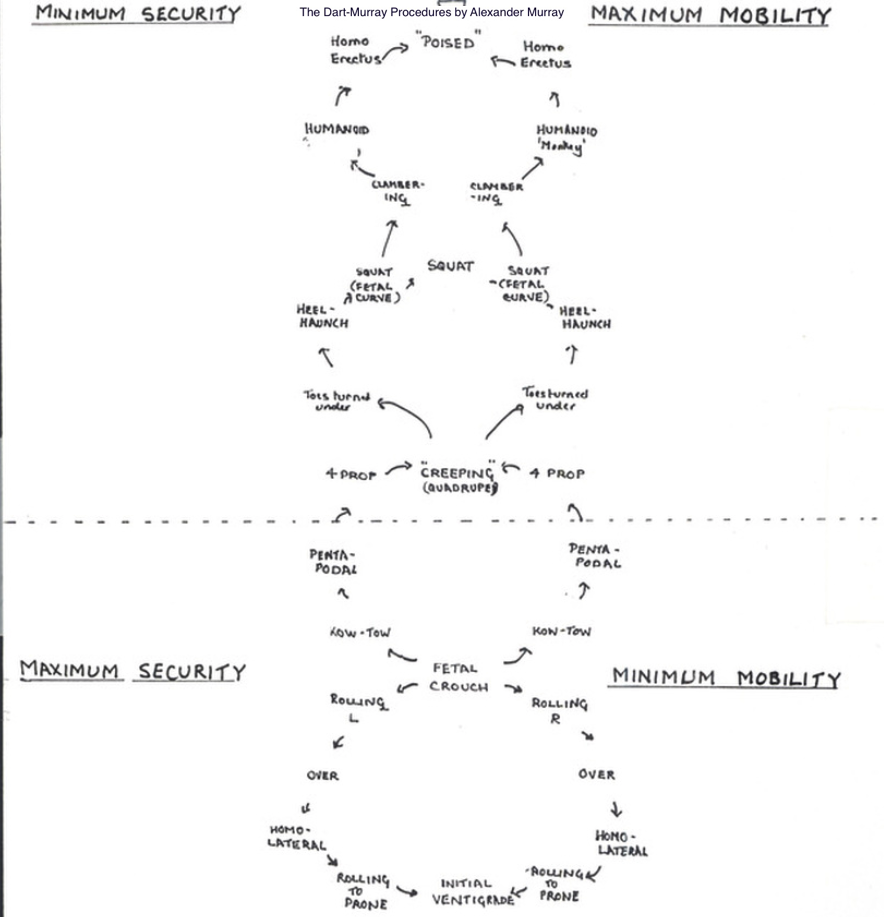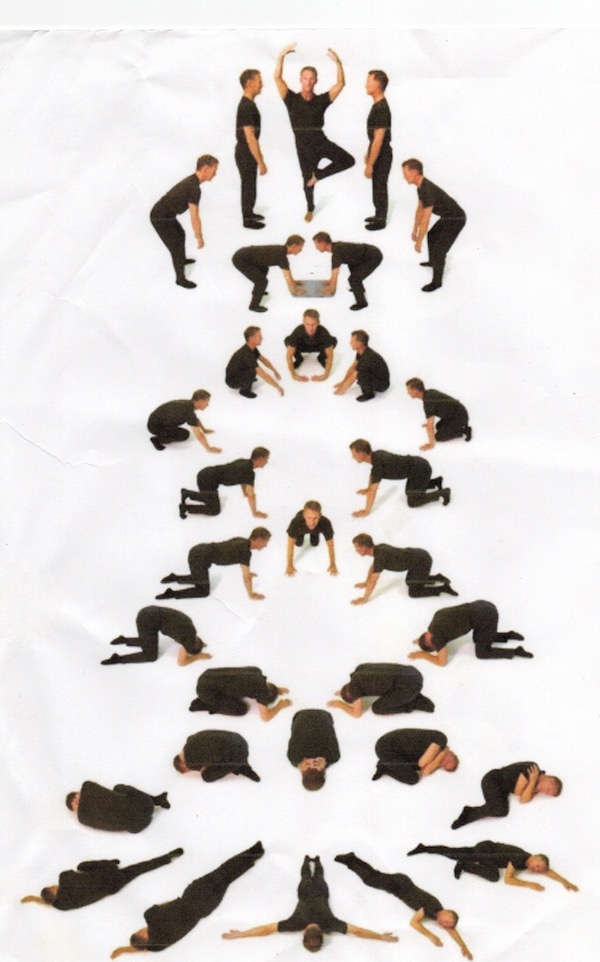

The Dart Procedures
The head moves in human beings in order to extend the range of vision; to better his vision man became completely upright.
– Raymond Dart
The Dart Procedures Website is intended primarily for Alexander Technique teachers, teacher-trainees, and students. The site is comprised largely of material generously provided to me by my teachers, Joan and Alexander Murray. This site is a "work in progress," as more material will be added. –Marian Goldberg
 |
Raymond A. Dart was a renowned anthropologist and anatomist. Professor Dart and his family had Alexander Technique lessons in South Africa during 1943-1944 with Irene Tasker, a teacher trained by F. M. Alexander. After Ms. Tasker left the country in 1944, Dart wanted to continue with the kind of help that he and his family, especially his brain-injured son, had received from their Alexander Technique lessons. Dart proceeded to use his vast science background in evolution and human development to develop new ways to work with his son and with himself. After World War II ended, Dart traveled to London and had a few lessons with F. M. Alexander and one lesson with Walter Carrington.
Unfortunately, Miss Tasker had to return to England shortly after our first meeting, but I continued studying the righful and wrongful performance of muscular acts so intensively that to a certain extent it bacame habitual. In the absence of my teacher I, too, has been forced to pursue a "do-it-yourself" technique. Within the next four years I had written three papers about what I had learned already therefrom—one for my anatomy students, one for my dental students, and one for our fellow members of the medical profession.
–Raymond Dart
An Anatomist's Tribute to F. Matthias Alexander
Through a later collaboration in the 1960s and 1970s with Alexander Technique teachers Joan and Alexander Murray, this inital work by Dart was developed into the Alexander Technique “Dart Procedures.” The Dart (Dart-Murray) Procedures are based on the observation of the natural coordination of infants, young children, and animals from an evolutionary perspective.
Illustrated History
The Dart (Dart-Murray) Procedures 1960s
Introduction by Alexander Murray
These Procedures will not teach one the Alexander Technique, but patient and intelligent investigation by one with no Alexander experience may reveal inefficient patterns of movement and help to discard them. Undertaken with the guidance of a skilled Alexander teacher, they are a constant source of insight and a point of reference in one’s patterns of behaviour. One can continually return to these as to Alexander’s “positions of mechanical advantage” in which category they certainly belong.
The Procedures are not exercises. Though muscular work is being done in response to gravity, this is a process of self-examination.
Professor Dart’s name came to my attention during a visit to Walter Carrington [a leading figure in teaching the Alexander Technique, trained by F. M. Alexander] in London in the summer of 1967. My wife and I had returned from our first year at Michigan State University where I was a professor of music and she was teaching the Alexander Technique to students and colleagues.
I had been considering the dynamic role of the jaw in head balance. My comments to Walter elicited the question: “Have you been reading Dart” I had not, but shortly after was at home with Dart's paper “The Postural Aspects of Malocclusion” [written in the 1940s].
Dart's paper described the procedures through which he had worked with his spastic son. This led to a fascinating series of experiments on myself, initially on my own, and later with help from my wife. These experiences gave us both an insight into human movement quite new to us and completely in line with what we had understood of Alexander’s work with which we had been familiar for 12 years.
As luck would have it, Professor Dart was passing through London on his way from South Africa to Philadelphia at the start of his long connection with the Institutes for the Achievement of Human Potential. We made out telephone contact which led to an invitation to visit him in Philadelphia on our return to the U.S.
This was an exciting time for all of us. After our initial visit at which we demonstrated the connection we had made between his work and Alexander’s, we said goodbye and watched Dart running down a hill to his headquarters, as he told us the following day, to read what he had written 25 years earlier!

The Procedures with Alex Murray in 1968, as the Murrays showed them initially to Raymond Dart.
The 'Procedures' as we presented them ot Professor Dart in 1967 were done in the following sequence:
1. Start on the toes. When this is done with the assistance of a skilled teacher, the primary control is activated and the whole system is tonified.
2. Shallow monkey position: hands on the back of the chair [developed by F. M. Alexander].
3. Knuckles on the back of the chair: This relates to what Dart call 'anthropoid' progression in 'The Postural Aspects of Malocclusion.'
4. Knuckles on the seat of the chair: The limbs are gradually folding, approximating more nearly to a creeping position.
The continuation until the final 'foetal crouch' is a reversal of the developmental sequence.
Each change should be guided by the Alexander Technique teacher, maintaining the activity of the primary control. These are all 'positions of mechanical advantage' for improving the conditions present. As Alexander says in Man's Supreme Inheritance:
The position of mechanical advantage, which may or may not be a normal position, is the position which gives the teacher the opportunity to bring about, with his own hands, a co-ordinated condition of the subject.
The Procedures are informative to anyone who does them patiently and openly. With the guidance of a skilled teacher, they are an invaluable addition to the repertoire of natural movements, the facilitation of which is part of the Alexander teacher's responsibility.
The Dart (Dart-Murray) Procedures 1970s
In 1967, when the Murrays showed Dart the initial connections they had made between his work and the Alexander Technique, Dart told the Murrays that they had not included the most important one, "fetal."

"Fetal"
The following early 1970s guides to the Procedures, created by Alex Murray and illustrator Pam Hartman, with the encouragement and approval of Raymond Dart, include fetal. The guides were also expanded to include other developmental movements and "positions of mechanical advantage."
The guide and illustrations are referred to in Dart's correspondence with the Murrays. See A Fascinating and Stimulating Exchange.
Trying to be aware is not the same as becoming aware.
The Procedures themselves are safe and at first require only very basic movement abilities, two qualities that in themselves promote (allow) a quieting and increasing awareness. They helped me in the beginning with what was then the vexing mystery of inhibition [Alexander Technique principle of inhibition]. After a time just being in any of the basic positions (positions of mechanical advantage) would start to bring my habits to awareness (so that stopping them became a possibility — paraphrasing F. M. Alexander, 'the wrong things stop themselves').
Inhibition became more tangible and approachable, if still a mystery. The same qualities, safeness and low demand on skill, helped me when it came to the movements involved in transitioning between the positions. It seemed to give me a clearer sense of the unity of working of primary control, that change could start at the head/neck or tail or anywhere in between. The change would then affect the entire mechanism over time. It also exaggerated/clarified the counterbalancing possibilities between the head-neck/shoulder girdle and the pelvis at the other end of Primary. It was when playing with rolling over and over and over from supine to prone, etc., that I had my first faint experience of 'The right thing does itself' per F. M. Alexander.
Kevin Ahern
Alexander Technique Teacher
Trained with the Murrays 1977-1980
The Dart (Dart-Murray) Procedures 1980s
Key to learning from exploration of the Dart Procedures is the practice of the Alexander Technique principles of Inhibition, the Means-Whereby, Direction, and Non-Endgaining. This allows for real, open-ended experimentation. Rather than trying to "sense" directly or to control sensations, learning and increased awareness happen through the observation of spontaneous changes in sensations.Marian Goldberg
Alexander Technique Teacher
Trained with the Murrays 1981-1985
The Dart (Dart-Murray) Procedures 1990s
In my 37 years of experience with Dart's work and the F. M. Alexander Technique, I have been asked, instructed, and/or encouraged to begin to look forward and up from a variety of positions: flat on my belly, creeping on all fours, fetal in the chair, etc. It has done me no end of good in the process of changing my use for the better. I have seen the same results in many people who have undergone the same instruction, including Alexander students with whom I have worked. The full exploration of lengthening and widening , involves co-equally the fronts (and sides) as well as the backs of our torsos (and necks and heads) and fully engages the 'Double Spiral Arrangement' delineated in Dart's relevant papers. My own experience suggests to me that many in the Alexander community remain unaware of the possible (and beneficial) extent of lengthening up the front. A related comment by F. M. Alexander appears on p. 86 of The Expanding Self by Goddard Binkley regarding the dynamic lengthening which is possible and necessary when looking up in the upright.–Kevin Ahern
The Dart (Dart-Murray) Procedures 2000s
Alex Murray (age 75) demonstrates coming up from the floor in 2005.
The Dart (Dart-Murray) Procedures going down to and up from the floor.
2014 Demonstration of the Dart Procedures with Alex Murray at age 85.
(This is a spontaneous postscript to his talk on
Raymond Dart and the Alexander Technique at the Freedom to Move
Conference in NYC May, 2014.)
2020 Interview with Joan Murray. The Dart (Dart-Murray) Procedures
Just let it all wash over you.
It is well worth the time and study it takes to assimilate Dart's writings. Keep in mind Dart's advice to Alex Murray when Alex first took up reading Dart: 'Just let it all wash over you . . . .' This indicates, I think, that if you read and reread over time with undemanding patience (especially if, like this reviewer, you have limited anatomical knowledge and limited capacity for increasing it), then what you need to know will gradually seep in. –Kevin Ahern
Raymond Dart had many published writings. The following four papers are connected to Dart's experience with the Alexander Technique. These papers, with accompanying illustrations and diagrams, were republished in Skill and Poise. (Available from the Society of Teachers of the Alexander Technique.)
"The Postural Aspects of Malocclusion." This article was first published in The Official Journal of the South African Dental Association, vol. 1, no, 1:1-21, September 1946. It includes a a description of the evolutionary/developmental procedures which Dart had developed to work with himself and his son. Summary of main points by Alex Murray. Origins of the paper.
The Attainment of Poise. First published in the South African Medical Journal 21:74-91, February 8, 1947.
Voluntary Musculatiure in the Human Body: The Double-Spiral Arrangement. The British Journal of Physical Medicine, vol. 13, no. 12:265-68, December 1950.
An Anatomist's Tribute to F. Matthias Alexander. The F. M. Alexander Memorial Lecture delivered before the Society of the Alexander Technique, March 20, 1970.
Neuromuscular Anatomy, Child Development, and Evolution for the Alexander Technique. AT Anatomy Weebly by Alexander Murray and Anna Evans.
A Fascinating and Stimulating Exchange: Dart's and the Murrays' written correspondence (1967 - 1971).
Dart and the Double Spiral by Carol Porter McCullough
The Dart Procedures by Rose Bronec and Rick Carbaugh
Beginning from the Beginning: The Growth of Understanding and Skill by Kevin Ahern, Marian Goldberg, and Joan and Alexander Murray
On the Course. The Colonel McConnel Connection (referred to in the Dart/Murray Correspondence). Writings and photos on topics related to the work of Joan and Alex Murray by Claire Happel Ashe.
What are the Dart Procedures? A clear and concise description of the history, practice, and rationale of the Dart Procedures by Erik Bendix, M.A.
Raymond Dart and the Art of Learning. 2020 video interview with Alex Murray.
Dance and the Alexander Technique. Exploring the Missing Link.
by Rebecca Nettl-Fiol and Luc Vanier
Return to:
Top of Page
The Dart Procedures Home Page
Alexander Technique: The Insiders' Guide
Alexander Technique: The Insiders’ Guide
The Dart Procedures
Websites created and maintained by Marian Goldberg, MSTAT
Alexander Technique Center of Washington
e-mail: info@alexandercenter.com
